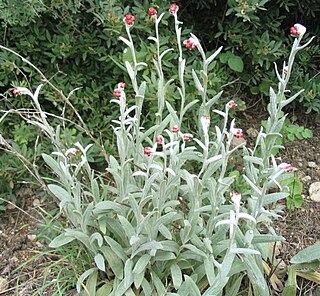
The genus Helichrysum consists of an estimated 600 species of flowering plants in the sunflower family (Asteraceae). The type species is Helichrysum orientale. They often go by the names everlasting, immortelle, and strawflower. The name is derived from the Ancient Greek words ἥλιος and χρῡσός.

The Gnaphalieae are a tribe of flowering plants in the family Asteraceae. It is most closely related to the tribes Anthemideae, Astereae, and Calenduleae.

Waitzia is a genus of Australian plants in the tribe Gnaphalieae within the family Asteraceae. The genus is native to Australia, where it grows in Western Australia, the Northern Territory, New South Wales, Victoria and South Australia.
- Waitzia acuminataSteetz - orange immortelle
- Waitzia corymbosaJ.C.Wendl.
- Waitzia nitida(Lindl.) Paul G.Wilson - golden waitzia
- Waitzia podolepis(Gaudich.) Benth.
- Waitzia suaveolens(Benth.) Druce - fragrant waitzia

Rhodanthe, also known as sunray or pink paper daisy, is a genus of Australian plants in the tribe Gnaphalieae within the family Asteraceae.

Chrysocephalum, known by the common name everlastings for their long life as cut flowers, is a genus of flowering plants in the family Asteraceae. There are nine species, all of which were formerly classified under other genera.
Chthonocephalus is a genus of annual herbs in the family Asteraceae. The genus is endemic to Australia, with species occurring in all mainland states.
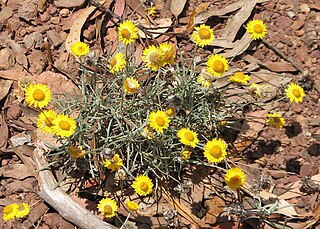
Leucochrysum is a genus of flowering plants in the tribe Gnaphalieae within the family Asteraceae, endemic to Australia.
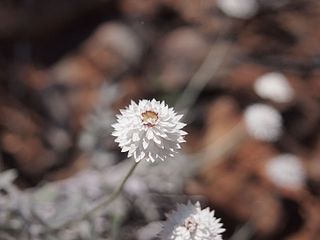
Anemocarpa is a genus of flowering plants in the family Asteraceae, endemic to Australia.
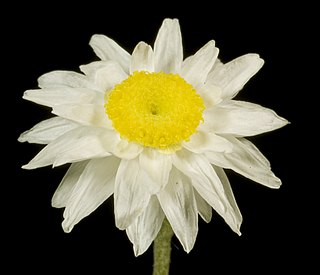
Hyalosperma is a genus of Australian flowering plants in the family Asteraceae.
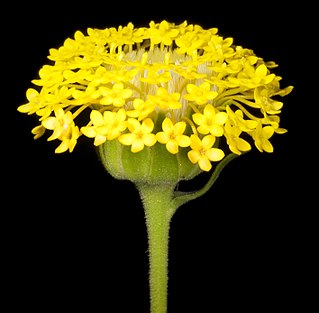
Podotheca is a genus of flowering plants in the tribe Gnaphalieae within the family Asteraceae. All species are endemic to Western Australia, except for Podotheca angustifolia which occurs across the south of Australia.

Chrysocephalum semipapposum, commonly known as clustered everlasting is a perennial shrub native to Australia. Clustered everlasting belongs to the family Asteraceae. C. semipapposum produces terminal flowers heads in clusters, mainly between spring and early summer with silver-grey appearing stems and branches. It grows up to 40cm high and 60 cm high, although there have been some varieties which can grow up to 1 m. C. semipapposum is often confused with Chrysocephalum apiculatum or 'yellow buttons', due to their similar appearances. C. semipapposum has 4 different subspecies, however they lack distinctive qualities and are often hard to identify. C. semipapposum is endemic to Australia and can be found in multiple states, most notably within Victoria. The plant is found in a variety of habitats including dry rocky regions. Clustered everlasting often grows sparsely and is rarely found in abundance and can be mistaken for a weed. Clustered everlasting has many uses, including as a source of nectar for butterflies, cut flowers or as an addition to a garden.
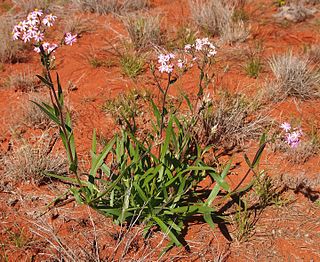
Schoenia is a genus of Australian plants in the tribe Gnaphalieae within the family Asteraceae.
Chrysanthellum is a genus of flowering plants in the aster family.

Waitzia acuminata, commonly known as orange immortelle, is an annual forb in the family Asteraceae. It is native to Australia. Plants grow to between 10 and 60 cm in height and have leaves that are long and narrow. These are between 2 and 7 cm long and 2 to 5 mm in width. The yellow, orange or white flowers appear between July and January. Waitzia Acuminata occurs in all mainland states of Australia and is currently not considered rare or endangered. Its genus Waitzia is named after German botanist Karl Friedrich Waitz. Acuminata is a latin name describing things that are tapered to a point, named after the plants spindle like outer bracts.
Haptotrichion is a genus of Australian plants in the tribe Gnaphalieae within the family Asteraceae.
Paul Graham Wilson is an Australian botanist. As of 1998, Wilson was the most prolific contributor to the journal Nuytsia, contributing to the first issue in 1970 and to the 12th volume in 1998, which was dedicated to him for his contributions to plant taxonomy and to celebrate his 70th birthday. Since his retirement from the Western Australian Herbarium in 1993, he has helped to maintain a comprehensive census of the flora of Western Australia.

Argentipallium niveum is a species of flowering plant within the genus, Argentipallium, in the daisy family (Asteraceae). It is endemic to Western Australia.

Pterochaeta is a monotypic plant genus in the Asteraceae family, endemic to Western Australia. It was first described in 1845 by Joachim Steetz and its only species is Pterochaeta paniculata.

Rhodanthe battii is a species of flowering plant in the family Asteraceae, native to Western Australia.

Argentipallium obtusifolium, commonly known as blunt everlasting, is a species of flowering plant in the family Asteraceae. It is a small, multi-stemmed perennial with white flowers, dark green leaves and is endemic to Australia.















